Helicopter Ka-62 and its features
The Ka-62 is a civilian version of the long-suffering Kamov's B-60 helicopter, which was later transformed into the Ka-60 Kasatka. The Kamov Design Bureau began developing a new military helicopter B-60 back in 1984. For the design bureau, this was the first rotary-wing machine made according to a single-rotor scheme with four-bladed main and eleven-bladed tail rotor.
The new helicopter initially had great potential in the civilian sphere, where Mi-4 helicopters were widely used to transport cargo weighing about two tons. After the removal of these machines from production and the gradual decommissioning, this niche remained unoccupied. Its larger multipurpose Mi-8 helicopters could not completely close it, since they were unprofitable in some directions due to the relatively large carrying capacity - up to 4 tons.
How did the Ka-60 become the Ka-62?
The draft design of the B-60 helicopter, which later became the Ka-60, was fully ready only in 1990. Throughout the entire existence of the project, the rotorcraft was repeatedly refined and improved, but never reached mass production. It is noted that the Kamov Design Bureau did not manage to bring the helicopter to the required level of transmission reliability, as well as the engines, which were the RD-600V.
As a result, in 2010, the Russian Ministry of Defense completely refused to finance the program for the creation of the Ka-60 Kasatka helicopter. The closure of the project was also influenced by the fact that a number of reconnaissance and combat functions of the Ka-60 were transferred to the Ka-52 Alligator reconnaissance and attack helicopter, which was put into mass production.
At the same time, the Ministry of Defense does not abandon possible plans for the militarization of the Ka-62 helicopter in the future. This machine began to be developed in the early 1990s. The helicopter was originally created as a civilian version of the military transport Ka-60, while retaining the main design features of the latter. For the first time, the Ka-62 helicopter model was shown as part of the MAKS-1995 air show. At the same time, the active stage of the project implementation began only in 2012, and the first test flight took place at the end of May 2017.
Currently, helicopters still have a lot in common. The appearance, layout and layout of the machines have been completely preserved. At the same time, the number of blades was changed on the Ka-62 helicopter. The number of rotor blades increased from four to five, and the tail rotor blades from 11 to 12 blades. The transition on the Ka-60 and Ka-62 helicopters to the traditional helicopter scheme instead of the coaxial one characteristic of the Kamov Design Bureau was motivated by the desire to increase the flight speed.
An interesting feature of the Ka-62 helicopter is the placement of the tail rotor in a closed circular channel (fenestron). This solution has several advantages. Firstly, it provides additional safety for the operating personnel of the rotorcraft. Secondly, this design solution allows you to reduce the noise level. Also, the tail rotor, located in the annular channel, improves the controllability of the helicopter.
Despite the fact that outwardly the Ka-60 and Ka-62 helicopters are as similar as possible, we are already facing completely different machines. The Ka-62 is a new helicopter, a new generation machine, the interior of the helicopter has been completely renewed. Thus, in the multipurpose Ka-62, the principle of "glass cockpit" was implemented, in which all information important for the pilots is displayed on LCD displays.
A significant advantage of the new helicopter is the fact that 60 percent of its weight falls on structures made of modern polymer composite materials (carbon fiber, fiberglass, organoplastic). Taken together, this made it possible to achieve an increase in flight speed, carrying capacity, as well as a decrease in fuel consumption of the vehicle. In this regard, the Russian helicopter industry does not lag behind the world today.
In an interview with TASS journalists, the director of Arsenyevskaya aviation of the Progress company noted that in September 2021 it is planned to complete the certification factory tests of the Ka-62 helicopter. The manufacturer expects to receive the type certificate and the certificate of the manufacturer of civil helicopter equipment by the end of 2021.
The helicopter already has its first official customer. As part of the MAKS-2021 air show, three Ka-62 helicopters were ordered by Gazprombank Leasing, which became the launch customer of the project.
Ka-62 should receive Russian engines
French engines are currently being installed on Ka-62 helicopters. These are gas turbine turboshaft engines of the new generation ARDIDEN 3G (by SAFRAN HE). The motors are modular in design and consist of three elements. The engines are started electrically, air intake for them occurs through radial air intakes. Maximum engine power 2x1776 hp. with. (takeoff mode). The power of the power plant with one failed engine within 2,5 minutes can be 1940 hp. with.
Currently, the Ka-62 helicopter is implementing an import substitution program.
First of all, import substitution should affect the engines and transmission of the rotorcraft. Over time, the French will have to be replaced by domestic engines. At the MAKS-2021 air show, the United Engine Corporation (UEC) showed a new VK-1600V engine, which is still in the demonstration engine stage.
According to the plans, a bulkhead of this engine will be carried out at the UEC-Klimov enterprise. By the end of the third quarter of this year, the engine is expected to be ready for the first tests. VK-1600V certification should take place within three years. After the completion of the import substitution program, the Ka-62 will be able to attract the attention of the Russian military department.
The VK-1600V engine is specially designed for the Ka-62 medium multipurpose helicopter. A distinctive feature of the engine is that it was created without flat drawings, directly in PMI format. The model of the new engine was originally presented as an electronic 3D model. The declared power range for this engine is from 1300 to 1800 hp. with.
Operating options for the Ka-62 helicopter
The Ka-62 multipurpose medium helicopter can occupy the currently empty niche of cargo transportation weighing up to two tons. The main areas of application of the new Russian helicopter should be passenger and cargo transportation, search and rescue operations, work in the oil and gas sector, and medical transportation. It is also possible that a special naval version and a version of the helicopter, adapted for operation in the Arctic, will appear.
Passenger transportation can also be carried out in conditions of increased comfort; VIP versions of the cabin will be available to customers. Transportation of various cargoes can be carried out both inside the transport cabin and on an external sling. Among other things, the Ka-62 helicopter can be used for patrol missions and environmental monitoring of the area.
Air ambulance should become an important field of application of the helicopter. The Ka-62 multipurpose helicopter is able to reach a maximum speed of 310 km / h, which is one of the best indicators among all medical helicopters in the world. Needless to say, patient evacuation speed is often critical to keeping them alive. Especially such helicopters will be in demand to provide assistance to patients in remote and hard-to-reach areas of the country.
Separately, the manufacturing company highlights the offshore version of the multipurpose helicopter. This modification is special and received a number of samples of unique equipment. All additional equipment allows the helicopter to operate over vast water areas.
This version of the Ka-62 is equipped with an additional fuel tank installed optionally in the luggage compartment, a high-intensity flashing beacon, an automatically separated radio beacon with built-in GPS / GLONASS sensors, and emergency cabin lighting. An important addition is the presence of an emergency landing system, which includes ballonets and life rafts for passengers and crew.
The competitive advantages of the Ka-62 helicopter in the Russian Helicopters holding include its structural versatility, which makes it easy to change the configuration of the transport cabin. In this case, all work on the modification of the cabin can be carried out by the forces of the operator of the equipment or the service team.
Flight performance of the Ka-62 multipurpose helicopter
The promising Russian medium multipurpose Ka-62 helicopter, created on the basis of the military modification of the Ka-60, is as close as possible to its predecessor in terms of flight performance. According to the Russian Helicopters holding, the normal take-off weight of the Ka-62 is 6500 kg, the maximum take-off weight is 6800 kg.
The multipurpose Ka-62 helicopter is able to carry up to 2000 kg in the cargo compartment, and up to 2500 kg of various cargoes on the external sling. The maximum cabin capacity is 15 passengers with a dense seating arrangement. In the comfort arrangement option - 12 passengers, in the deluxe cabin - from 9 passengers or less. For the carriage of passengers' luggage, a spacious compartment is provided with access to it from the left and right sides of the car. The helicopter crew consists of 1–2 pilots.
Wide side sliding doors provide easy boarding and disembarkation of passengers, and six windows in the passenger compartment are extruded and can be used in an emergency as emergency exits. In the version of the medical helicopter, the Ka-62 can simultaneously transport two bedridden patients with medical personnel in a cabin isolated from the cockpit. At the same time, the manufacturer declares the possibility of emergency transportation of up to four victims on a stretcher, accompanied by doctors.
The Ka-62 medium multipurpose helicopter has an excellent flight speed. The maximum speed at normal take-off weight is 310 km / h (with the maximum - 300 km / h), the cruising flight speed is 290 km / h and 285 km / h, respectively. The rate of climb of the helicopter at a normal take-off weight is 14 m / s. Service ceiling 6100 meters, hovering ceiling (outside the influence of the earth) - 3200 meters (values for the normal take-off weight of the machine).
The maximum flight range at a barometric altitude of 500 meters with a full refueling of the main tanks is estimated at 700 km. The flight range of the Ka-62 with a payload of 1000 kg is 580 km, with a payload of 2000 kg - 100 km. The maximum time spent in the air with a full refueling of the main tanks at a barometric altitude of 500 meters is 4 hours and 3,7 hours at normal and maximum take-off weights, respectively.
The maximum length of the Ka-62 helicopter from nose to tail is 13,47 meters, along the edge of the rotor blades - 15,7 meters. The width of the helicopter's cabin is 1,895 meters. The maximum helicopter height is 4,51 meters. The main rotor diameter is 13,8 meters, the tail rotor diameter is 1,4 meters.
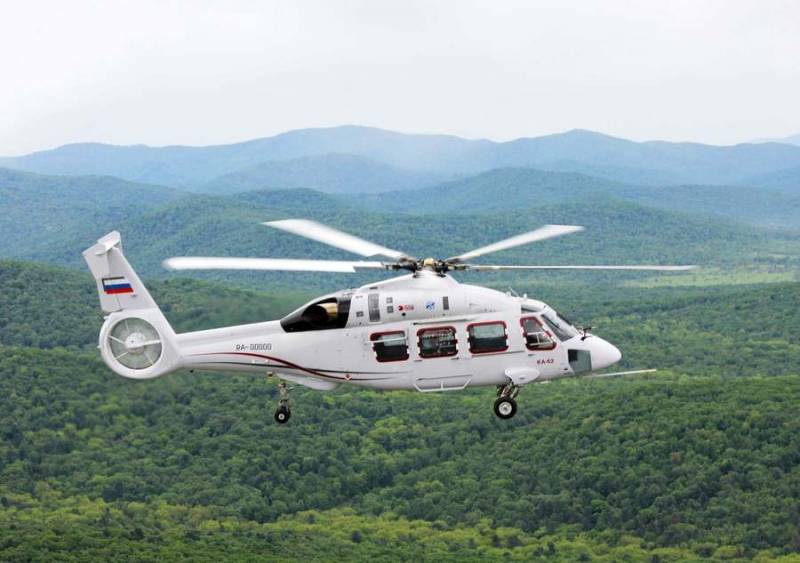
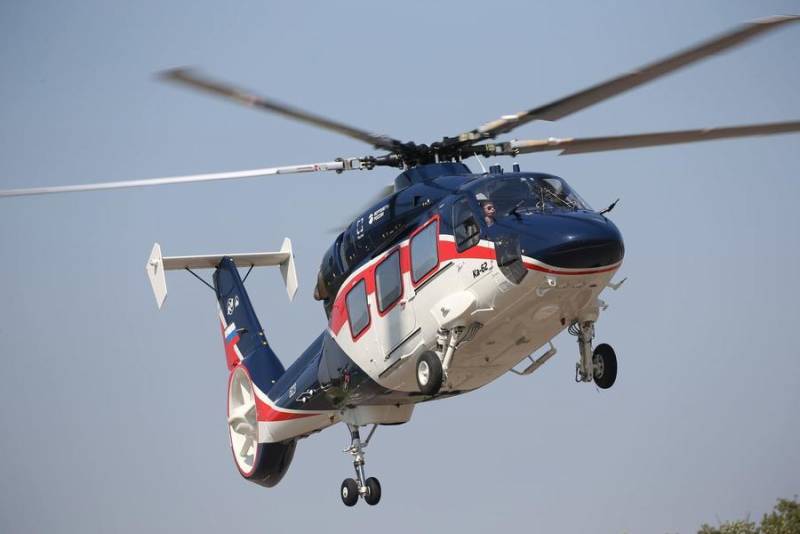
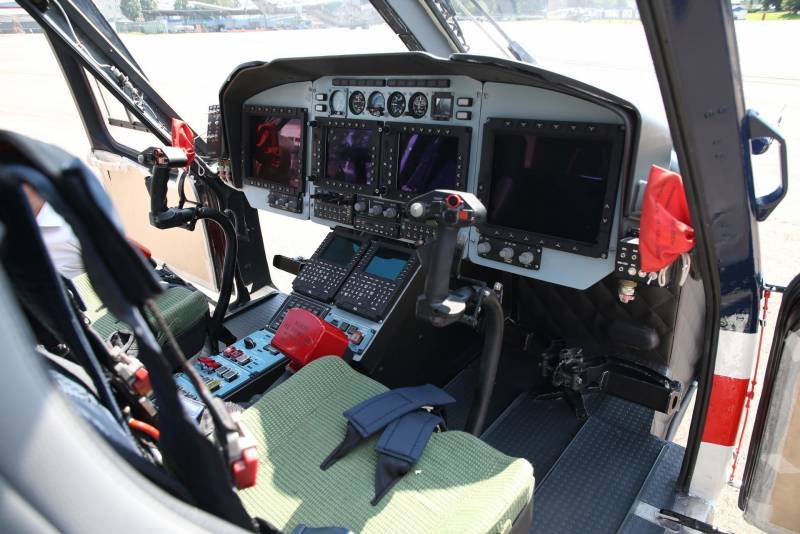
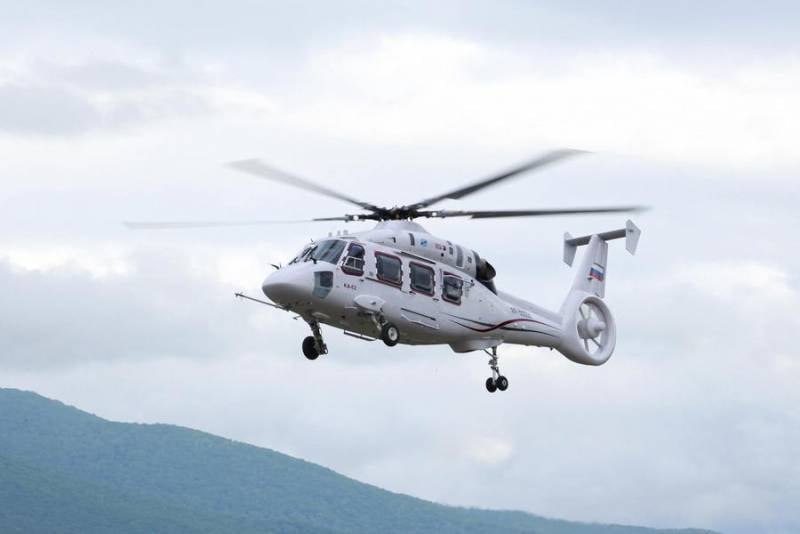
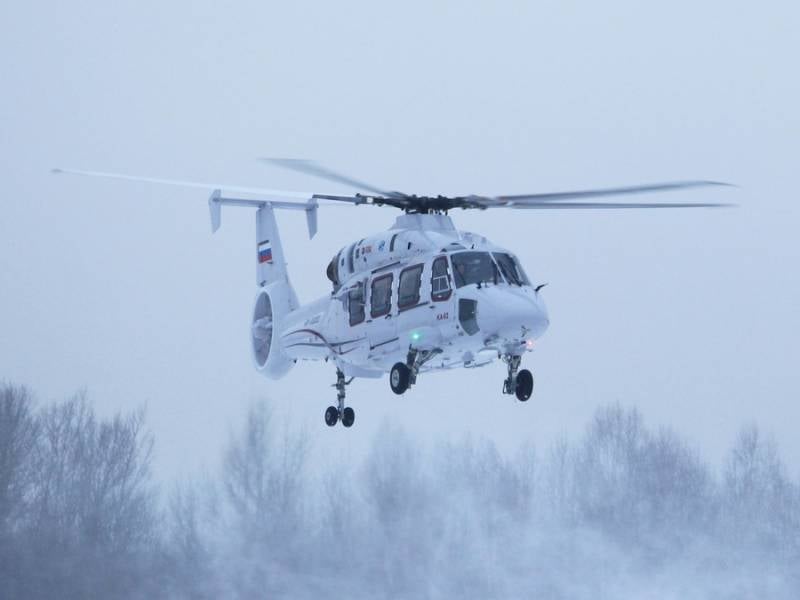
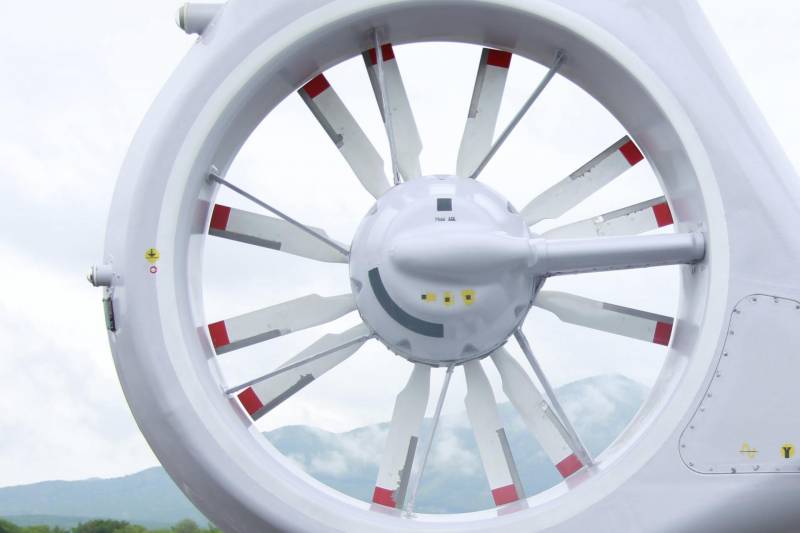
Information